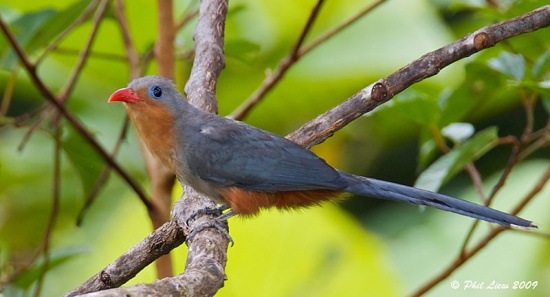m (→Identification: Amend link) |
|||
| (10 intermediate revisions by 6 users not shown) | |||
| Line 1: | Line 1: | ||
| − | + | [[Image:Red Billed Malkoha 1.jpg|thumb|550px|right|Photo by {{user|996sps|996sps}}<br>Sepilok, Sabah, [[Malaysia]], May 2009]] | |
| − | [[Image:Red | + | ;[[:Category:Zanclostomus|Zanclostomus]] javanicus |
| + | ''Phaenicophaeus javanicus'' | ||
==Identification== | ==Identification== | ||
| + | 42cm | ||
| + | * Grey upperparts | ||
| + | * Glossed bluish green on back and wings | ||
| + | * White tipped tail | ||
| + | * Rufous underparts with grey lower-breast bar | ||
| + | * Grey or blue bare skin around eye | ||
| + | * Red bill with blackish [[Topography#Beaks|culmen]] | ||
| + | Sexes similar. Juveniles also similar but with narrow [[Topography#Tails|rectrices]] and shorter white tip of tail. | ||
==Distribution== | ==Distribution== | ||
| + | Found from southern [[Burma]] and southern [[Thailand]] through peninsular [[Malaysia]] to [[Sumatra]], [[Borneo]] and [[Java]].<br /> | ||
| + | Uncommon or rare to locally common. | ||
==Taxonomy== | ==Taxonomy== | ||
| + | This is a [[Dictionary_M-O#M|monotypic]] species.<br /> | ||
| + | Placed in genus ''[[:Category:Zanclostomus|Zanclostomus]]'' by Dickinson (2003) and Gill & Wright (2008). Formerly placed in ''[[:Category:Phaenicophaeus|Phaenicophaeus]]''. | ||
==Habitat== | ==Habitat== | ||
| + | Subtropical or tropical dry forests.<br /> | ||
| + | Occurs from lowlands to hilly areas up to 1000m, sometimes up to 1500m. | ||
==Behaviour== | ==Behaviour== | ||
| + | ====Diet==== | ||
| + | Feeds on large insects. Takes also spiders and crustaceans. | ||
| + | ====Breeding==== | ||
| + | Breeds in June in Malaysia, April in Kalimantan. A [[Dictionary_M-O#M|monogamous]] species. The nest is a flimsy platform made of twigs. The eggs are chalky white. | ||
| + | ====Movements==== | ||
| + | A resident species. | ||
| + | ==References== | ||
| + | #{{Ref-Clements6thAug17}}#{{Ref-HBWVol4}}#{{Ref-GillDonsker12V3.2}} | ||
| + | {{ref}} | ||
==External Links== | ==External Links== | ||
| − | {{GSearch| | + | {{GSearch|Malkoha+javanicus}} |
| − | + | [[Category:Birds]] [[Category:Zanclostomus]] | |
| − | [[Category: | ||
Revision as of 22:59, 27 October 2017
- Zanclostomus javanicus
Phaenicophaeus javanicus
Identification
42cm
- Grey upperparts
- Glossed bluish green on back and wings
- White tipped tail
- Rufous underparts with grey lower-breast bar
- Grey or blue bare skin around eye
- Red bill with blackish culmen
Sexes similar. Juveniles also similar but with narrow rectrices and shorter white tip of tail.
Distribution
Found from southern Burma and southern Thailand through peninsular Malaysia to Sumatra, Borneo and Java.
Uncommon or rare to locally common.
Taxonomy
This is a monotypic species.
Placed in genus Zanclostomus by Dickinson (2003) and Gill & Wright (2008). Formerly placed in Phaenicophaeus.
Habitat
Subtropical or tropical dry forests.
Occurs from lowlands to hilly areas up to 1000m, sometimes up to 1500m.
Behaviour
Diet
Feeds on large insects. Takes also spiders and crustaceans.
Breeding
Breeds in June in Malaysia, April in Kalimantan. A monogamous species. The nest is a flimsy platform made of twigs. The eggs are chalky white.
Movements
A resident species.
References
- Clements, J. F., T. S. Schulenberg, M. J. Iliff, D. Roberson, T. A. Fredericks, B. L. Sullivan, and C. L. Wood. 2017. The eBird/Clements checklist of birds of the world: v2017, with updates to August 2017. Downloaded from http://www.birds.cornell.edu/clementschecklist/download/
- Del Hoyo, J, A Elliot, and J Sargatal, eds. 1997. Handbook of the Birds of the World. Volume 4: Sandgrouse to Cuckoos. Barcelona: Lynx Edicions. ISBN 978-8487334221
- Gill, F and D Donsker (Eds). 2012. IOC World Bird Names (version 3.2). Available at http://www.worldbirdnames.org/.
Recommended Citation
- BirdForum Opus contributors. (2024) Red-billed Malkoha. In: BirdForum, the forum for wild birds and birding. Retrieved 26 April 2024 from https://www.birdforum.net/opus/Red-billed_Malkoha




